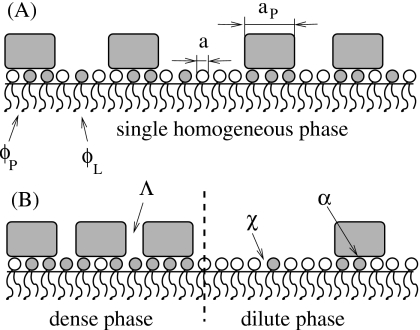Figure 1.
Schematic illustration of (A) local lipid segregation vs (B) global phase separation. In the former case, proteins (shaded rectangles) bind to a preferred lipid species (lipids with shaded headgroups) without causing the formation of large domains. Even though the membrane compositions ϕP and ϕL,within the protein-covered regions and bare membrane, respectively, may differ from each other, the membrane remains homogeneous on a macroscopic scale. In the latter case, there is macroscopic phase separation into a protein-dense and protein-dilute phase. The ability of proteins to induce phase separation depends on the lipid-protein binding strength (α), lipid-lipid interaction (χ), and protein-protein interaction (Λ). The only structural parameter that enters our model is the protein’s number of binding sites or, equivalently, protein-to-lipid size ratio σ=aP∕a, where aP and a denote the cross-sectional areas per protein and lipid, respectively.

